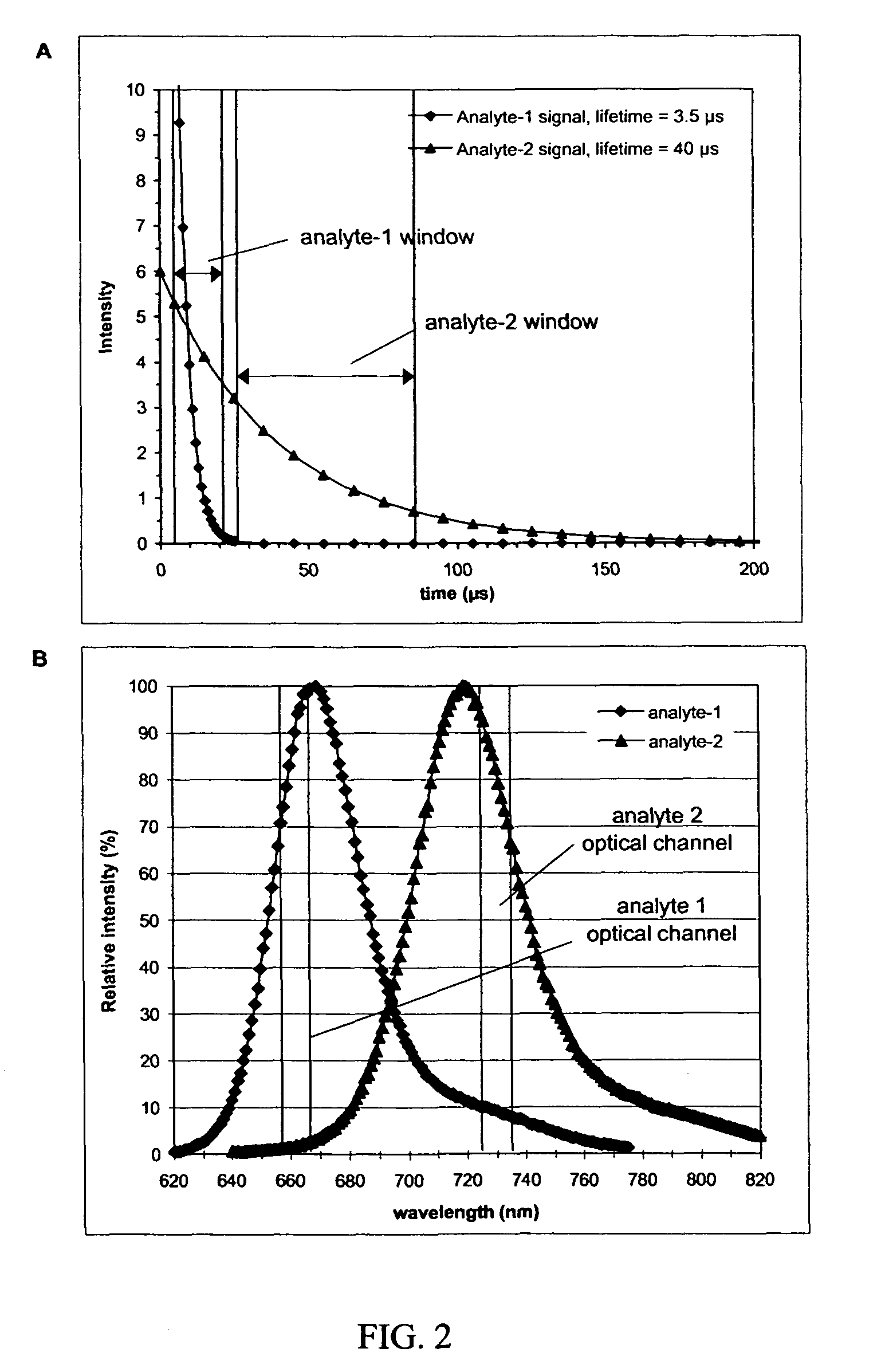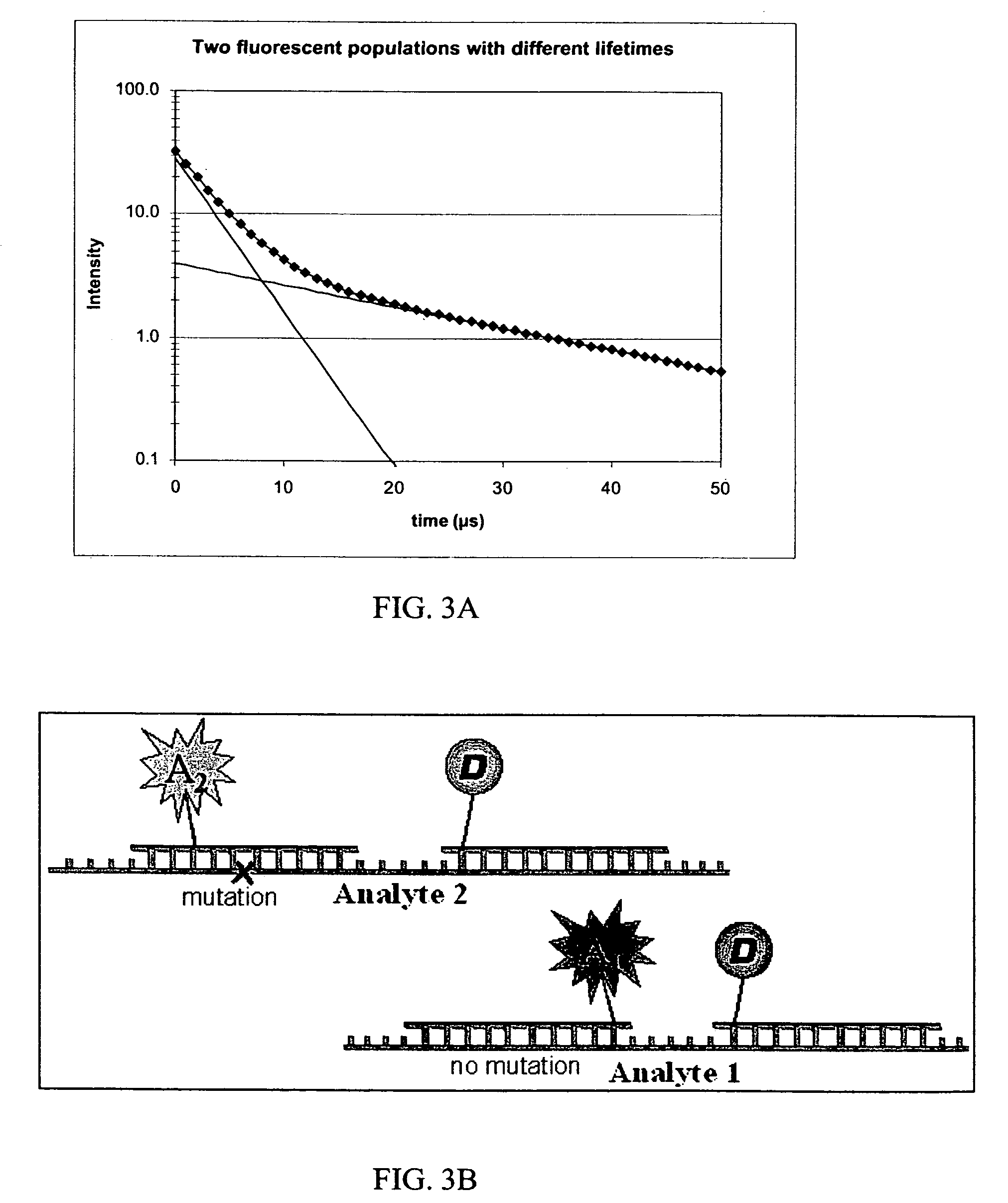Homogeneous time-resolved energy transfer assay
a time-resolved energy transfer and homogeneous technology, applied in biochemistry equipment and processes, biochemistry apparatus and processes, material testing goods, etc., can solve the problems of limiting the sensitivity of acceptor emission based fret assays, and broad emission spectra of suitable acceptor fluorophores, etc., to achieve enhanced sensitivity, increase the signal/background ratio, and increase the energy transfer efficiency
- Summary
- Abstract
- Description
- Claims
- Application Information
AI Technical Summary
Benefits of technology
Problems solved by technology
Method used
Image
Examples
example 1
[0054]Adjustment of energy-transfer based acceptor fluorescence lifetime in homogenous FRET-assay for ΔF508 mutant DNA target.
[0055]The homogenous assay for ΔF508 mutant DNA was carried out using four different donor- and acceptor-probe combinations (table 1). These probe combinations allowed to carry out four different modifications of the same assay, in which the lifetime of the energy-transfer based acceptor signal is adjusted by the use of different donor-acceptor distances (D-A distances: 6, 8, 10 or 12 base pairs (bp) single stranded DNA).
[0056]
TABLE 1Delta F508 target5′ TTAAAGAAAATATCATTGGTGTTTCCTATGATGAATATAGATACAGAAGCGTCA 3′(SEQ ID NO: 1)WO1724-ALEXAFLUOR ® 6473′ Alexa647-modU-TACTTATATCTATGTCTTC 5′(SEQ ID NO: 2)WO1725-ALEXAFLUOR ® 6473′ Alexa647-modU-TATATCTATGTCTTCGC 5′(SEQ ID NO: 3)WO1726-Eu3′AAATTATAGTAACCACAAA-Eu 5′(SEQ ID NO: 4)WO1727-Eu3′AAATTTTATAGTAACCACA-Eu 5′(SEQ ID NO: 5)D-A PAIRD-A DISTANCE (BP)WO1724-Alexa647 + WO1726-Eu6WO1724-Alexa647 + WO1727-Eu8WO1725-Alex...
example 2
Adjustment of Lifetime of the Energy-Transfer Based Acceptor Fluorescence by the Use of Different Spectral Overlap Factors
[0063]The ability to change energy-transfer efficiency and the lifetime of the energy-transfer based acceptor fluorescence by changing the spectral overlap factor was demonstrated in a DNA double strand based FRET model system, which is illustrated in table 3. In model system W8044-Eu donor labeled DNA strand was hybridized with acceptor labeled DNA strand. Five different versions of the acceptor strand, which contained the same DNA-sequence but different fluorescent acceptor dye, were synthesized. After hybridization the D-A distance was the same in each sample but due to the different absorbtion properties of the acceptor dyes the spectral overlap factor with the donor and thereby the R0 was different for every sample.
[0064]DNA sequences were synthesized using standard phosphoramidite chemistry (Expedite 8909 DNA-synthesizer, PerSeptive Biosystems) and were fur...
example 3
Optimized Detection Sensitivity for ΔF508 Mutant DNA Target
[0070]Based on results from the example 1 the D-A distance 8 by was selected as the most suitable distance for shortened time scale TR-measurement in ΔF508 mutant DNA assay. Further, the donor and the acceptor probes were switched so that the Alexa 647 labeled probe (acceptor-probe) was now specific to the ΔF508 mutation site and the W8044-Eu labeled probe (donor probe) binds 8 base pairs next to the acceptor probe. Probe sequences are illustrated in table 5.
[0071]
TABLE 5Delta-F508 target5′ TTAAAGAAAATATCATTGGTGTTTCCTATGATGAATATAGATACAGAAGCGTCA 3′(SEQ ID NO: 1)WO17053′AAATTTTATAGTAACCACA-ALEXAFLOUR ® 647 5′(SEQ ID NO: 5)WO17393′ Eu-TACTTATATCTATGTCTTC 5′(SEQ ID NO: 2)
[0072]The probes were synthesized and labeled using methods described in example 1. Also now the hybridization conditions (NaCl-concentration, temperature and probe excess) and TR-measurement window (delay and window length) were optimized to obtain the best sen...
PUM
| Property | Measurement | Unit |
|---|---|---|
| time | aaaaa | aaaaa |
| time | aaaaa | aaaaa |
| delay time | aaaaa | aaaaa |
Abstract
Description
Claims
Application Information
 Login to View More
Login to View More - R&D
- Intellectual Property
- Life Sciences
- Materials
- Tech Scout
- Unparalleled Data Quality
- Higher Quality Content
- 60% Fewer Hallucinations
Browse by: Latest US Patents, China's latest patents, Technical Efficacy Thesaurus, Application Domain, Technology Topic, Popular Technical Reports.
© 2025 PatSnap. All rights reserved.Legal|Privacy policy|Modern Slavery Act Transparency Statement|Sitemap|About US| Contact US: help@patsnap.com



